Japan Wood Products
Prices
Dollar Exchange Rates of
25th February 2015
Japan Yen 118.98
Reports From Japan
GDP growth spurred by rising exports
With final quarter 2014 GDP returning to positive territory
the Japanese economy pulled out of recession. Final
quarter 2014 GDP rose 0.6%, a welcome sign but analysts
were expecting a stronger rebound.
The improvement in GDP was achieved on the back of
rising exports. Exports to China are growing as Chinese
consumers are responding to the government‟s efforts to
boost domestic consumption.
First quarter exports to the US, Japan‟s largest export
market, were the best for almost five years. However,
there are risks to sustained growth as the economies of
China and the EU face difficulties.
Japan‟s GDP growth in the final quarter of 2014 was
largely export driven but higher consumer spending will
be the only way for the upward trend to be sustained. In a
note of caution the Bank of Japan said lower energy costs
if sustained will slow progress toward its inflation target of
2%.
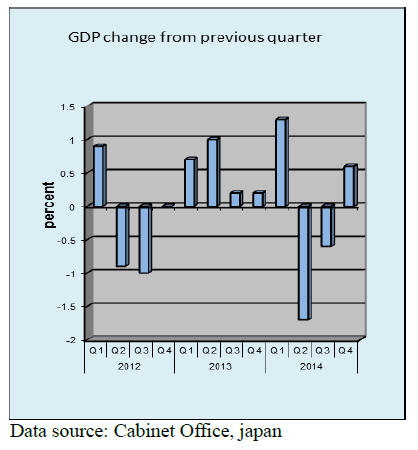
SMEs manufacturers cheered by talk of government
support
The final quarter 2014 survey of sentiment among Japan's
manufacturers paints a depressing picture with sentiment
amongst the large enterprises slipping by three points
emphasising the pessimistic mood of manufacturers.
However smaller manufacturers were cheered by talk of
government support for small enterprises which lifted the
sentiment index for the small manufacturer group out of
negative territory.
For the first quarter of 2105 the projection provided in the
Tankan suggests a continuing downward trend in
sentiment. This is not a surprise as domestic consumption
remains weak.
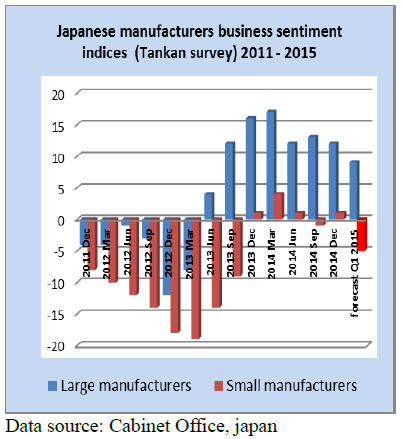
Japan‟s annual exports in January jumped the most since
late 2013 in an encouraging sign the weak yen is finally
helping the economy crawl out of recession.
January Housing starts affected by bad weather
January housing starts totaled 68,000 units, down from the
76,000 units in December 2104, an almost 11% drop. Year
on year, January starts were 13% down.
Analysts were surprised by the sharp drop in January
housing starts even taking into consideration the very bad
weather in northern and western Japan which has brought
construction to a halt.
On the brighter side, construction companies in Japan
reported an increase in orders during January.
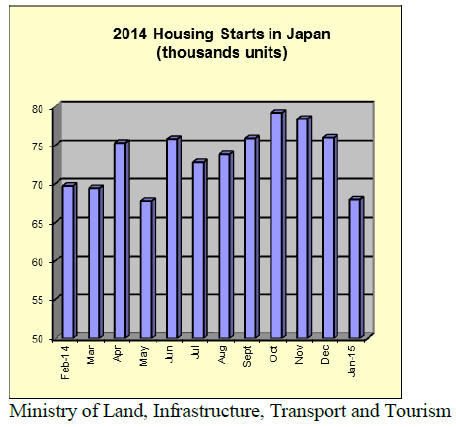
Data suggests weaker yen boosted exports
The yen strengthened slightly towards the end of February
as the Bank of Japan announced it has no immediate plans
for further monetary easing.
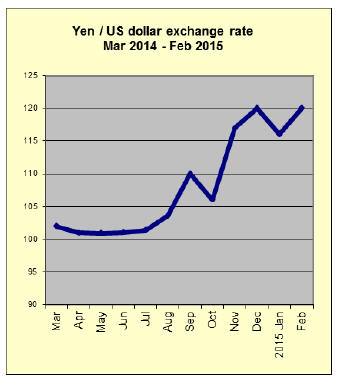
Recent data suggest that the weaker yen is boosting
exports. January 2015 exports rose at the fastest rate since
late 2013 and exporters are confident on prospects for the
next three months despite a deteriorating global outlook.
The 17% year-on-year increase in January 2015 exports
was the fifth monthly improvement driven by shipments of
vehicles and electronics.
Furniture consumption trends
Japan‟s Statistics Bureau compiles an index on furniture
and household item consumption and the trend is
illustrated below.
Two things are readily apparent; there is a recurring
increase in consumption just after companies in Japan pay
the summer bonuses (June or July) to workers and the
steep rise in furniture consumption just prior to the
increase in consumption tax in April 2014.
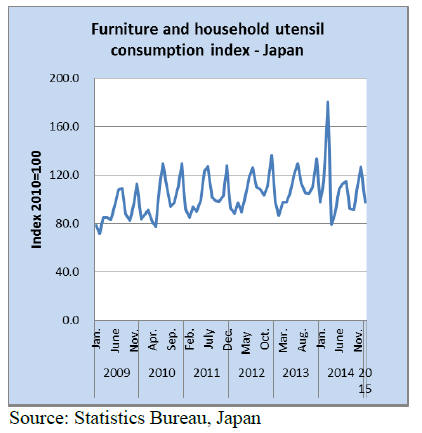
Japan’s furniture imports
2015 got off to a good start for suppliers of bedroom
furniture to Japan. January import statics reveal a sharp
rise in bedroom furniture imports compared to levels in
December, building upon the gain seen at the end of 2014.
In contrast kitchen furniture imports in Janauary 2015
were flat while office furniture imports rose marginally.
In comparison to imports in January 2014, Japan‟s office
furniture imports in January 2015 were up around 4%.
Imports of Kitchen furniture over the same period were
down 5% and bedroom furniture imports were also down
(2%) in January 2015 compared to the same month in
2014.
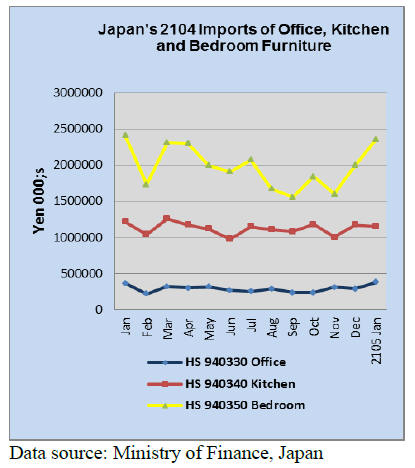
Office furniture imports (HS 940330)
In January 2015 suppliers in three countries, China,
Portugal, and Italy accounted for around 84% of all office
furniture imports to Japan. Compared to December 2014
imports from China during January Japan‟s imports rose
36%, imports from Portugal fell 15% while imports from
Italy doubled.
Of tropical suppliers only Malaysia, Indonesia and
Vietnam supplied office furniture in January but their
combined contribution to overall imports was just 4%.
Suppliers in the EU, in contrast, accounted for 38% of
Japan‟s office furniture imports.
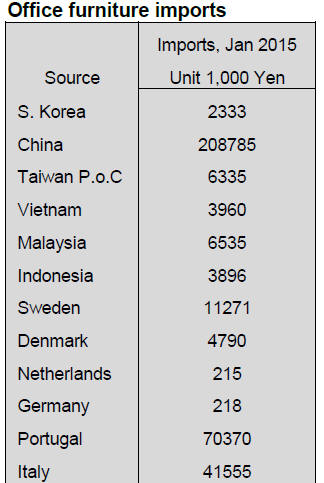
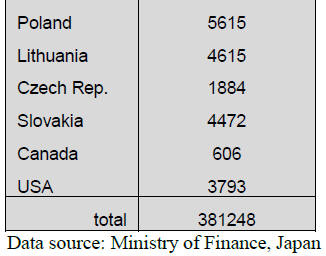
Kitchen furniture imports (HS 940340)
In January this year Vietnam held on to the position of
number one supplier of kitchen furniture to Japan. Imports
from China in January 2015 were up 24% year on year but
Vietnam suppliers could only manage a 6% improvement
on December figures. The other two major suppliers,
Philippines and Indonesia, saw imports fall close to 20%.
The top four suppliers, China, Philippines, Vietnam and
Indonesia accounted for 94% of all Japan‟s January 2015
kitchen furniture imports. Suppliers in SE Asia; Vietnam,
Thailand, Malaysia, Philippines and Indonesia accounted
for 80% of Japan‟s January 2015 kitchen furniture
imports.
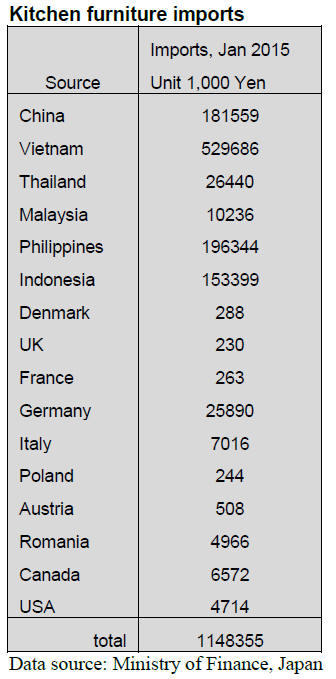
Bedroom furniture imports (HS 940350)
Suppliers in SE Asia accounted for around 40% of Japan‟s
bedroom furniture imports in January 2015. Of the five SE
Asian countries shipping bedroom furniture to Japan the
largest supplier was Vietnam.
Other suppliers were Thailand, Malaysia Philippines and
Indonesia.
Despite the strong performance of SE Asian suppliers,
China dominated January bedroom furniture imports by
Japan where it saw its contribution to total imports climb
14% however, this rise was dwarfed by the massive 58%
increase in supplies from Vietnam.
Both Thailand and Malaysia saw a decline in January 2105
shipments of bedroom furniture to Japan.
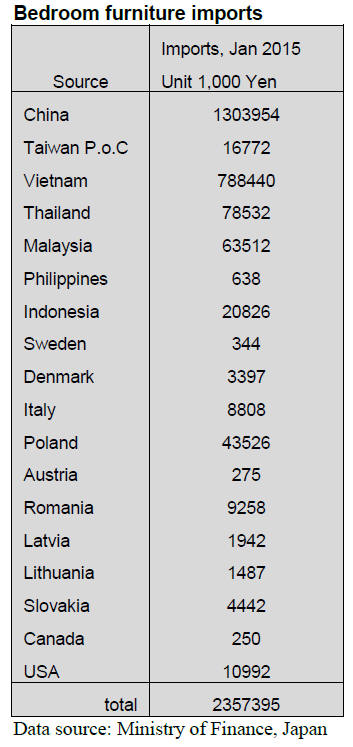
Trade news from the Japan Lumber Reports (JLR)
For the JLR report please see:
http://www.nmokuzai.
com/modules/general/index.php?id=7
North American log imports in 2014
Total import of North American logs in 2014 was 3,047 M
cbms, 10.8% less than 2013. Log import in 2013 increased
by 14% than 2012 due to rush-in import before the
consumption tax hike so 2014 volume dropped compared
to active import in 2013.
In the first half of 2014, demand was hot and orders
increased and the supply could not catch up busy demand
but in the second half, the demand sharply decreased and
import volume dropped clearly.
At the beginning of last year, general forecast was
reactionary drop of demand related to the increase of
consumption tax should not be so much but foresight went
wrong and the market struggled with heavy inventories in
weak demand. Sawmills and plywood mills could not buy
until their inventories decreased so the purchase volume
dropped.
By unloading port, Kure and Kashima, where Chugoku
Lumber has sawmills, remain top and second but the
volume for Kure decreased by 20.7% from 2013 and the
volume for Kashima also declined by 7.5%.
Ta Ann Plywood builds veneer plant
Ta Ann Plywood (Sibu, Sarawak, Malaysia, K.H.Won,
president) is building veneer plant in Bintulu, which will
start up the operation in June this year. It will use 3,000
cbms of acacia logs as raw material to produce 1,500 cbms
of veneer. Veneer plant is built near acacia plantation and
veneer is hauled to plywood plant to save transportation
cost.
Total production of plywood plant will increase to about
20,0000 cbms a month. Plan is to make concrete forming
panel for coating and structural panel for Japan market.
Plywood
Domestic softwood plywood market is weakly holding.
Deliveries of orders in December delayed by truck
shortage but they completed in January so new orders
started in late January.
The manufacturers proposed higher prices in late
November and again in December but delay of deliveries
confused the market and dealers were busy finishing order
balances in January.
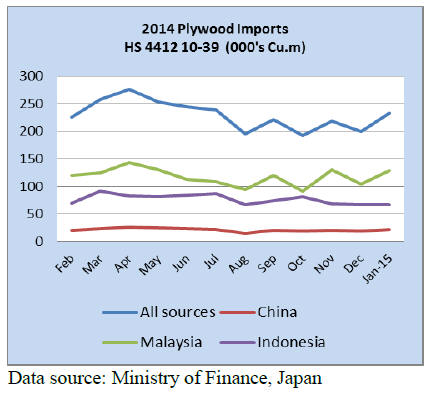
The movement is slow in the middle of winter and price
quotations by precutting plants and large dealers are
getting severe. Current market prices in Tokyo are 850-
860 yen per sheet delivered, slightly down from last
month.
Total softwood plywood production in 2014 was
2,617,100 cbms, 0.4% less than 2013 and the shipment
was 2,523,400 cbms, 5.6% less. Import plywood market
continues flat since last December. Since late
January, higher cost cargoes started arriving but price
increase is difficult by absence of demand.
Wholesalers, which have low cost inventories, do not have
to increase the sales prices so much based on their cost so
the market prices do not go up.
Since last October, many ships arrived at one time so that
unloading works delayed and port inventories increased.
In Tokyo market, prices of JAS 3x6 concrete forming for
coating are 1,400-1,420 yen per sheet delivered, no change
from January.
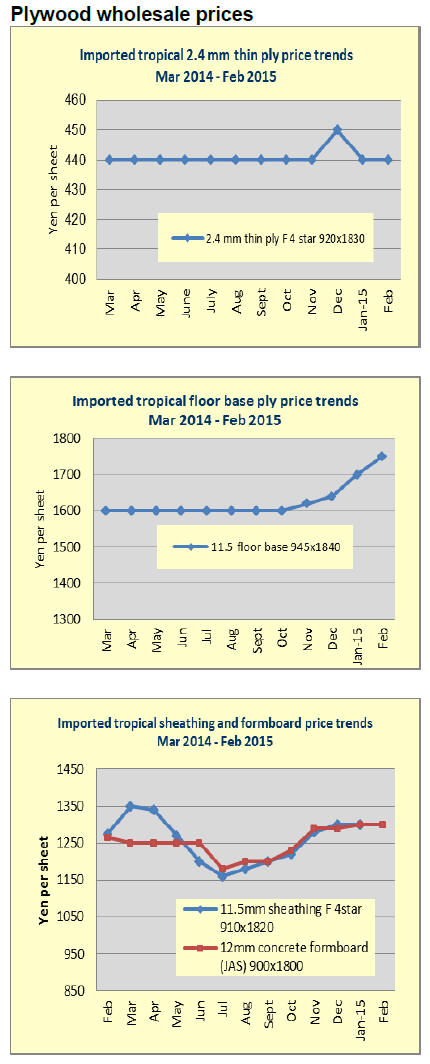
|